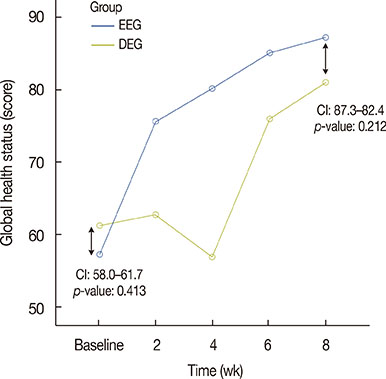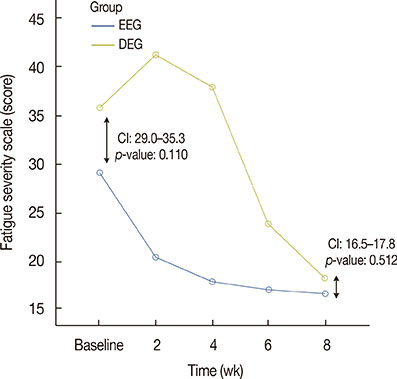J Breast Cancer.
2015 Mar;18(1):87-96. 10.4048/jbc.2015.18.1.87.
Effects of a 4-Week Multimodal Rehabilitation Program on Quality of Life, Cardiopulmonary Function, and Fatigue in Breast Cancer Patients
- Affiliations
-
- 1Department of Rehabilitation Medicine, Asan Medical Center, University of Ulsan College of Medicine, Seoul, Korea. jyjeon71@gmail.com
- KMID: 2286342
- DOI: http://doi.org/10.4048/jbc.2015.18.1.87
Abstract
- PURPOSE
This study examines the effects of a rehabilitation program on quality of life (QoL), cardiopulmonary function, and fatigue in breast cancer patients. The program included aerobic exercises as well as stretching and strengthening exercises.
METHODS
Breast cancer patients (n=62) who had completed chemotherapy were randomly assigned to an early exercise group (EEG; n=32) or a delayed exercise group (DEG; n=30). The EEG underwent 4 weeks of a multimodal rehabilitation program for 80 min/day, 5 times/wk for 4 weeks. The DEG completed the same program during the next 4 weeks. The European Organization for Research and Treatment of Cancer-Core Quality of Life Questionnaire (EORTC QLQ-C30), EORTC Breast Cancer-Specific Quality of Life Questionnaire (EORTC QLQ-BR23), predicted maximal volume of oxygen consumption (VO2max), and fatigue severity scale (FSS) were used for assessment at baseline, and at 2, 4, 6, and 8 weeks.
RESULTS
After 8 weeks, statistically significant differences were apparent in global health, physical, role, and emotional functions, and cancer-related symptoms such as fatigue and pain, nausea, and dyspnea on the EORTC QLQ-C30; cancer-related symptoms involving the arm and breast on the EORTC QLQ-BR23; the predicted VO2max; muscular strength; and FSS (p<0.050), according to time, between the two groups.
CONCLUSION
The results of our study suggest that a supervised multimodal rehabilitation program may improve the physical symptoms, QoL, and fatigue in patients with breast cancer.
Keyword
MeSH Terms
Figure
Reference
-
1. National cancer statistics. Ministry of Health and Welfare: 2014. Accessed June 13th, 2014. http://www.cancer.go.kr/mbs/cancer/subview.jsp?id=cancer_040101000000.2. Sant M, Allemani C, Berrino F, Coleman MP, Aareleid T, Chaplain G, et al. Breast carcinoma survival in Europe and the United States. Cancer. 2004; 100:715–722.
Article3. Markes M, Brockow T, Resch KL. Exercise for women receiving adjuvant therapy for breast cancer. Cochrane Database Syst Rev. 2006; (4):CD005001.
Article4. Partridge AH, Burstein HJ, Winer EP. Side effects of chemotherapy and combined chemohormonal therapy in women with early-stage breast cancer. J Natl Cancer Inst Monogr. 2001; (30):135–142.
Article5. McNeely ML, Campbell KL, Rowe BH, Klassen TP, Mackey JR, Courneya KS. Effects of exercise on breast cancer patients and survivors: a systematic review and meta-analysis. CMAJ. 2006; 175:34–41.
Article6. McKenzie DC, Kalda AL. Effect of upper extremity exercise on secondary lymphedema in breast cancer patients: a pilot study. J Clin Oncol. 2003; 21:463–466.
Article7. Cantarero-Villanueva I, Fernández-Lao C, Del Moral-Avila R, Fernández-de-Las-Peñas C, Feriche-Fernández-Castanys MB, Arroyo-Morales M. Effectiveness of core stability exercises and recovery myofascial release massage on fatigue in breast cancer survivors: a randomized controlled clinical trial. Evid Based Complement Alternat Med. 2012; 2012:620619.
Article8. Hwang JH, Chang HJ, Shim YH, Park WH, Park W, Huh SJ, et al. Effects of supervised exercise therapy in patients receiving radiotherapy for breast cancer. Yonsei Med J. 2008; 49:443–450.
Article9. Milne HM, Wallman KE, Gordon S, Courneya KS. Effects of a combined aerobic and resistance exercise program in breast cancer survivors: a randomized controlled trial. Breast Cancer Res Treat. 2008; 108:279–288.
Article10. Yun YH, Park YS, Lee ES, Bang SM, Heo DS, Park SY, et al. Validation of the Korean version of the EORTC QLQ-C30. Qual Life Res. 2004; 13:863–868.
Article11. Pollock ML, Wilmore JH, Fox SM. Health and Fitness through Physical Activity. New York: John Wiley & Sons;1978.12. Taylor RR, Jason LA, Torres A. Fatigue rating scales: an empirical comparison. Psychol Med. 2000; 30:849–856.
Article13. Ford-Smith CD, Wyman JF, Elswick RK Jr, Fernandez T. Reliability of stationary dynamometer muscle strength testing in community-dwelling older adults. Arch Phys Med Rehabil. 2001; 82:1128–1132.
Article14. Kisner C, Colby LA. Therapeutic Exercise: Foundations and Techniques. 4th ed. Philadelphia: F.A. Davis;2002.15. Eyigor S, Kanyilmaz S. Exercise in patients coping with breast cancer: an overview. World J Clin Oncol. 2014; 5:406–411.
Article16. Behm DG, Anderson K, Curnew RS. Muscle force and activation under stable and unstable conditions. J Strength Cond Res. 2002; 16:416–422.
Article17. Valachis A, Polyzos NP, Georgoulias V, Mavroudis D, Mauri D. Lack of evidence for fracture prevention in early breast cancer bisphosphonate trials: a meta-analysis. Gynecol Oncol. 2010; 117:139–145.
Article18. Mutrie N, Campbell AM, Whyte F, McConnachie A, Emslie C, Lee L, et al. Benefits of supervised group exercise programme for women being treated for early stage breast cancer: pragmatic randomised controlled trial. BMJ. 2007; 334:517.
Article19. Zabora J, BrintzenhofeSzoc K, Curbow B, Hooker C, Piantadosi S. The prevalence of psychological distress by cancer site. Psychooncology. 2001; 10:19–28.
Article20. Oldervoll LM, Rø M, Zwart JA, Svebak S. Comparison of two physical exercise programs for the early intervention of pain in the neck, shoulders and lower back in female hospital staff. J Rehabil Med. 2001; 33:156–161.
Article21. Blanchard CM, Stein KD, Baker F, Dent MF, Denniston MM, Courneya KS, et al. Association between current lifestyle behaviors and health-related quality of life in breast, colorectal, and prostate cancer survivors. Psychol Health. 2004; 19:1–13.
Article22. Segar ML, Katch VL, Roth RS, Garcia AW, Portner TI, Glickman SG, et al. The effect of aerobic exercise on self-esteem and depressive and anxiety symptoms among breast cancer survivors. Oncol Nurs Forum. 1998; 25:107–113.23. So WK, Marsh G, Ling WM, Leung FY, Lo JC, Yeung M, et al. The symptom cluster of fatigue, pain, anxiety, and depression and the effect on the quality of life of women receiving treatment for breast cancer: a multicenter study. Oncol Nurs Forum. 2009; 36:E205–E214.
Article24. Cormie P, Galvão DA, Spry N, Newton RU. Neither heavy nor light load resistance exercise acutely exacerbates lymphedema in breast cancer survivor. Integr Cancer Ther. 2013; 12:423–432.
Article25. Ahmed RL, Thomas W, Yee D, Schmitz KH. Randomized controlled trial of weight training and lymphedema in breast cancer survivors. J Clin Oncol. 2006; 24:2765–2772.
Article26. Lee EH, Moon S, Song Y, Chun M. Relationships of lymphedema, the shoulder range of motion, fatigue and social support to the health related quality of life in patients with breast cancer. J Breast Cancer. 2010; 13:212–218.
Article27. Crowley S. The effect of a structured exercise program on fatigue, strength, endurance, physical self-efficacy, and functional wellness in women with early stage breast cancer. Virginia Henderson International Nursing e-Repository;2004. Accessed September 16th, 2014. http://hdl.handle.net/10755/165449.28. Kang DM, Park YK, Lee YH, Sul JG. Validity on submaximal load tests using cycle ergometer in evaluation of maximum oxygen consumption volume. J Korean Soc Occup Environ Hyg. 2006; 16:145–151.29. Karageanes SJ. Principles of Manual Sports Medicine. Philadelphia: Lippincott Williams & Wilkins;2005.30. Windsor PM, Nicol KF, Potter J. A randomized, controlled trial of aerobic exercise for treatment-related fatigue in men receiving radical external beam radiotherapy for localized prostate carcinoma. Cancer. 2004; 101:550–557.
Article
- Full Text Links
- Actions
-
Cited
- CITED
-
- Close
- Share
- Similar articles
-
- Effects of a Comprehensive Rehabilitation Program for Mastectomy Patients
- The Effects of a Rehabilitation Program on Physical Health, Physiological Indicator and Quality of Life in Breast Cancer Mastectomy Patients
- Impacts of Fatigue, Pain, Anxiety, and Depression on the Quality of Life in Patients with Breast Cancer
- Effects of Comprehensive Rehabilitation Program on Physical Function and Fatigue in Mastectomy Patients
- Trajectory of Fatigue, Quality of Life and Physical Symptoms in Cancer Patients Receiving Radiotherapy





